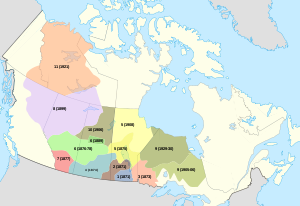| Treaty No. 6 between Her Majesty the Queen and the Plain and Wood Cree Indians and Other Tribes of Indians at Fort Carlton, Fort Pitt, and Battle River with Adhesions | |
|---|---|
 The Numbered Treaties | |
| Signed | 23 and 28 August and 9 September 1876 |
| Location | Fort Carlton, Fort Pitt |
| Parties | |
| Language | English |
| Indigenous peoples in Canada |
|---|
 |
|
|
Treaty 6 is the sixth of the numbered treaties that were signed by the Canadian Crown and various First Nations between 1871 and 1877. It is one of a total of 11 numbered treaties signed between the Canadian Crown and First Nations. Specifically, Treaty 6 is an agreement between the Crown and the Plains and Woods Cree, Assiniboine, and other band governments at Fort Carlton and Fort Pitt. Key figures, representing the Crown, involved in the negotiations were Alexander Morris, Lieutenant Governor of Manitoba and The North-West Territories; James McKay, The Minister of Agriculture for Manitoba; and William J. Christie, a chief factor of the Hudson's Bay Company. Chief Mistawasis and Chief Ahtahkakoop represented the Carlton Cree.[1]
Treaty 6 included terms that had not been incorporated into Treaties 1 to 5, including a medicine chest at the house of the Indian agent on the reserve, protection from famine and pestilence, more agricultural implements, and on-reserve education. The area agreed upon by the Plains and Woods Cree represents most of the central area of the current provinces of Saskatchewan and Alberta.
The treaty signings began on 18 August 1876 and ran until 9 September 1876. Additional adhesions, when bands within the Treaty area signed on, were signed later, including a Manitoba band in 1898, and, later that year, the last was signed in the Montreal Lake area.

Since Treaty 6 has been signed, there have been many claims over miscommunication of the treaty terms from the Indigenous and the Crown's perspective. This misunderstanding has led to disagreements between the Indigenous peoples and the government over the different interpretations of the treaty terms.[2]
Treaty 6 is still active today, and a Treaty 6 Recognition Day has been celebrated in Edmonton each August since 2013 to remember the signing in 1876.
- ^ Chalmers (1977), p. 23.
- ^ Asch (1997), p. 197.
© MMXXIII Rich X Search. We shall prevail. All rights reserved. Rich X Search
